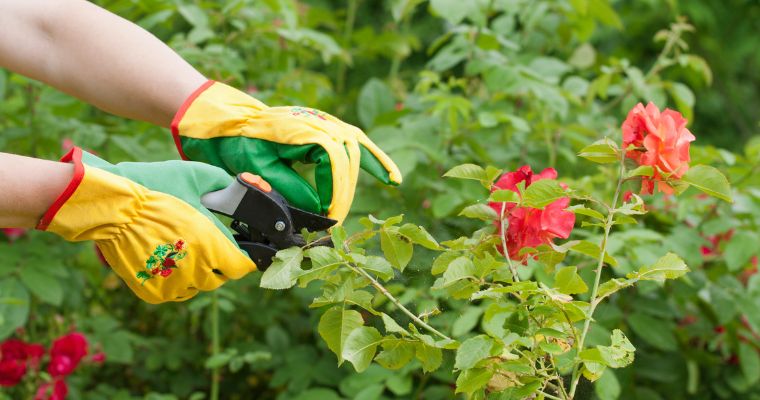This post delves into the heart of ‘how to prune roses’. So, let’s get those gloves on and step into our flower-filled gardens.
Roses need regular pruning to maintain their beauty. While this might seem daunting to beginner gardeners, don’t worry. Equipped with patience, a bit of knowledge, and the right tools, you’ll master the art of rose pruning in no time.

Why do we need to prune roses?
Pruning your roses helps maintain their health and vigour. It encourages new growth, improves air circulation (thereby reducing the risk of disease), and results in more robust, beautiful blooms. Pruning also keeps the shape of your roses under control, so they don’t become too tangled or straggly.
When is the best time to prune roses?
The best time to prune your roses is in early spring, just as the buds start to swell on the plant. You’ll want to look for signs of new growth, as that’s your cue to grab your tools and get to work.
This is usually after the last hard frost. For warmer climates, where roses never truly go dormant, light pruning can be done throughout the year, but the primary pruning is still done in early spring.
Speaking of tools: what will you need?
Bypass Pruners
Bypass pruners are a must-have for any rose enthusiast. They’re perfect for making clean cuts on live wood. Remember to keep them sharp and clean.
Loppers
If you need to prune thicker branches, a pair of loppers will be your best friend.
Pruning saw
For the tough stuff – deadwood and branches, use a pruning saw.
Gardening gloves
Roses are beautiful, but they fight back! Thick thorn-proof gloves will protect your hands.
Disinfectant
Keep a bottle of rubbing alcohol or a similar disinfectant nearby to clean your tools. It helps prevent the spread of disease from one plant to another.
Now we’ve got our toolkit, it’s time to dive into the ‘how-to’ of pruning roses.
How to prune roses
- Clean your tools: Start by disinfecting your pruning tools. As I mentioned earlier, this helps prevent disease spread.
- Identify the 3 D’s: Dead, Diseased, and Damaged wood. These are your primary targets for removal. Deadwood often looks dry and is typically dark brown or black.
- Make a plan: Take a step back and evaluate the shape and structure of your rose bush. You want to create an open centre to allow good air circulation and easy access to sunlight.
- The 45-degree rule: Make your cuts about a quarter inch above an outward-facing bud at a 45-degree angle. This encourages outward growth and helps shed water away from the bud.
- Crossing canes: Canes that are crossing or rubbing against each other can create wounds, making the plant more susceptible to disease. Decide which cane is healthier or better positioned, and remove the other.
- Final touch-ups: After making all the significant cuts, step back and reassess. You may need to even out the plant a bit more or remove some smaller, weaker canes.
- Clean up: Collect and dispose of all the cut material properly. It’s a good practice not to compost rose cuttings as they could harbour disease.
Pruning can feel like a bit of an art, but with a little practice and patience, you’ll find it becomes second nature. Remember, roses are resilient, and it’s hard to make a mistake they won’t recover from in time. So take a deep breath, trust your instincts, and take that first cut.
By learning how to prune roses, you’re investing in the health and beauty of your garden. And as the season rolls around and your roses burst into their full glory, you’ll know it was all worth it. Happy pruning!
Enjoy this Post? Support Sue Foster on Ko-fi


